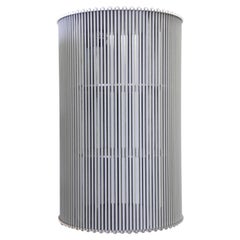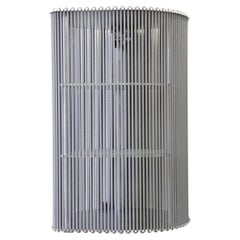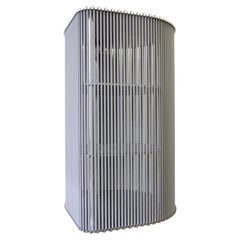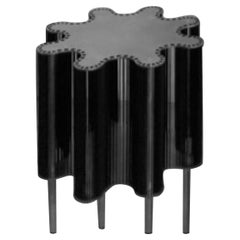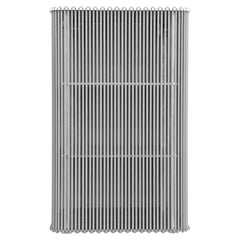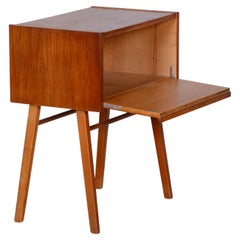Polystyrene Side Tables
13
1
to
9
14
1
2
5
1
13
1
1
Height
to
Width
to
Depth
to
424
17,543
11,480
5,363
3,896
8
5
3
2
2
2
1
1
Material: Polystyrene
Coil Circle Cabinet Wall Mounted / Side Table by Bram Kerkhofs
Located in Geneve, CH
Coil circle cabinet wall mounted / side table by Bram Kerkhofs
Dimensions: D 40 x W 40 x H 75.2cm
Materials:Stainless steel, aluminium, elastic rope (natural rubber, polyethylene)....
Category
2010s Belgian Post-Modern Polystyrene Side Tables
Materials
Aluminum, Stainless Steel
Coil Square Circle Cabinet Wall Mounted/ Side Table by Bram Kerkhofs
Located in Geneve, CH
Coil square circle cabinet wall mounted/ side table by Bram Kerkhofs
Dimensions: D 40 x W 40 x H 75.2cm
Materials:Stainless steel, aluminium, elastic rope (natural rubber, polyethylene).
Other dimensions are available.
COIL is a modular cabinet system...
Category
2010s Belgian Post-Modern Polystyrene Side Tables
Materials
Aluminum, Stainless Steel
Coil Drop Cabinet Wall Mounted/ Side Table by Bram Kerkhofs
Located in Geneve, CH
Coil drop cabinet wall mounted/ side table by Bram Kerkhofs
Dimensions: D 40 x W 40 x H 75.2cm
Materials:Stainless steel, aluminium, elastic rope (natural rubber, polyethylene).
...
Category
2010s Belgian Post-Modern Polystyrene Side Tables
Materials
Aluminum, Stainless Steel
Meander I2 Side Table / Low Cabinet by Bram Kerkhofs
Located in Geneve, CH
Meander I2 side table / low cabinet by Bram Kerkhofs.
Dimensions: D 51 x H 73cm.
Materials: Stainless steel, aluminum, elastic rope (natural rubber, polyester).
Other dimensions are available.
Meander is the latest fruit of an ongoing research that started from the system ‘Coil’ in which round elastic rope is connected to a stable material, resulting in screens from parallel stretched strings. Using flat elastic band with different widths and playing with interspacing, meander allows to create semi-transparent screens with a lot of variations.
Out of its system Meander can be implemented exterior, as architectural screens packing buildings or dividing space, or interior, as room dividing screens. But above all it allows to create sensual objects that play with shape, transparency, motion and optical confusion.
The possibilities are endless!
Bram Kerkhofs (° 1977) is a Belgian furniture designer looking for new forms and methods to challenge the functionality and flexibility of a furniture piece. Educated as a goldsmith he is fascinated by connections, hinges, knots and joints, and especially by the functional opportunities they generate. His work is filled with mathematical principles resulting in intelligible algorithms to make them understandable. He draws particular attention to the relationship between construction and material, bringing simplicity into complexity, with a lasting alertness to the final function. This time-intensive design and development process results in innovative construction systems automatically expressing his signature. Many of his designs must be seen in a bigger picture, as parts to a whole, in which he explores the endless possibilities for links, combinations and variations.
Bram wants to clarify complex constructions and gives the consumer and the spectator insight into his thinking process. That is why his work partly revolves around people, as the manipulators...
Category
2010s Belgian Post-Modern Polystyrene Side Tables
Materials
Aluminum, Stainless Steel
Coil Square Cabinet Wall Mounted/ Side Table by Bram Kerkhofs
Located in Geneve, CH
Coil square cabinet wall mounted/ side table by Bram Kerkhofs
Dimensions: D 40 x W 40 x H 75.2cm
Materials: Stainless steel, aluminium, elastic rope (natural rubber, polyethylene).
Other dimensions are available.
COIL is a modular cabinet system...
Category
2010s Belgian Post-Modern Polystyrene Side Tables
Materials
Aluminum, Stainless Steel
Titi 01 Table and Stool by Mary-Lynn & Carlo
Located in Geneve, CH
TITI 01 table and stool by Mary-Lynn & Carlo, 2021.
The Elephant Project.
Dimensions: stool H 42 x W 42 x D 42 cm.
Table H 45 x W 98 x D 35 cm.
Materials: concrete colored, foam...
Category
2010s Lebanese Modern Polystyrene Side Tables
Materials
Concrete
Contemporary Heavy Side Table in textured resin and Duco
Located in London, GB
Heavy is a series of furniture that explores the relationship between form and material, blending the ideas of man made and nature. Inspired by ancient Dolmen structures and Brutalis...
Category
2010s South African Modern Polystyrene Side Tables
Materials
Foam, Polystyrene
Goofy Bedside Table by Mary-Lynn & Carlo
Located in Geneve, CH
Goofy Bedside Table by Mary-Lynn & Carlo
Dimensions: H 50 x W 60 x D 50 cm
Materials: concrete colored, foam polystyrene
Finish: water, stains repellent
Color can be customized.
...
Category
2010s Lebanese Modern Polystyrene Side Tables
Materials
Concrete
Pau Silver V2 Low Table by Edizione Limitata
Located in Geneve, CH
Pau silver V2 low table by Edizione Limitata
Limited Edition of 150 pieces. Signed and numbered.
Dimensions: D 50 x W 70 x H 41 cm.
Materials: Resin-coated polistyrene wtih metall...
Category
2010s Italian Post-Modern Polystyrene Side Tables
Materials
Resin, Polystyrene
Pau V2 Low Table by Edizione Limitata
Located in Geneve, CH
Pau V2 low table by Edizione Limitata
Limited Edition of 150 pieces. Signed and numbered.
Dimensions: D 50 x W 70 x H 41 cm.
Materials: Resin-coated polistyrene.
Edizione Limit...
Category
2010s Italian Post-Modern Polystyrene Side Tables
Materials
Resin, Polystyrene
Sculpture "Solid Formations No 1" by Stine Mikkelsen
Located in Geneve, CH
Sculpture "Solid Formations no 1" by Stine Mikkelsen
Dimensions: 130 x 145 x 56 cm
Materials: Composite material based on crushed granite and fish glue. The inner construction is...
Category
2010s Danish Minimalist Polystyrene Side Tables
Materials
Granite
Contemporary Heavy Low Table in textured resin and duco
Located in London, GB
Heavy is a series of furniture that explores the relationship between form and material, blending the ideas of man made and nature. Inspired by ancient Dolmen structures and Brutalis...
Category
2010s South African Modern Polystyrene Side Tables
Materials
Foam, Polystyrene
Crest and Trough Contemporary Side Table
Located in London, GB
When two waves encounter each other, they make ‘interference pattern’. Crest and trough create a resultant wave of greater, lower or the same amplitude in this superposition and thes...
Category
2010s Korean Modern Polystyrene Side Tables
Materials
Polystyrene
Marc Newson Red 'Gello' Table Made for Les 3 Suisses in 1994, Original Box
By Marc Newson
Located in London, GB
The Gello was only produced for a very short time and only a limited quantity few are left in existence.
An extraordinary clever design.
As a mail-order product the table needed to be ultra lightweight and easy to assemble. Newson designed the table in three very simple parts, choosing a high frequency welded PVC plastic sheet for the base, a piece of plastic tubing to hold it together and a vacuum formed polystyrene for the top.
3 Suisses...
Category
1990s Australian Kinetic Polystyrene Side Tables
Materials
Polystyrene, PVC, Polymer
Related Items
‘Rosewood Cabinet’ Patterned Wall-Mounted Wood Cabinet, Schimmel and Schweikle
Located in Antwerp, BE
Functional art meets contemporary design with the ‘Rosewood Cabinet’ by design duo Janne Schimmel (Dutch) and Moreno Schweikle (German). Featuring 3D printed elements combined with t...
Category
2010s Dutch Other Polystyrene Side Tables
Materials
Metal, Aluminum
H 15.75 in W 20.87 in D 12.21 in
Czech Mid-Century Side Table, Cabinet Made Out of Oak, 1950s, Refreshed Polish
Located in Horomerice, CZ
Completely restored Czech mid-century side table - cabinet made out of oak, 1950s, refreshed polish.
Stable construction
Refreshed polish
Fully functional
Period: 1950-1959.
Category
Mid-20th Century Czech Mid-Century Modern Polystyrene Side Tables
Materials
Oak
H 30.71 in W 25.2 in D 27.56 in
Bellagio Low Side Table
By Morelato
Located in Milan, IT
This low side table has a calacatta marble top that elegantly complements the walnut ash wood structure. Bellagio is a new collection characterized by ...
Category
2010s Italian Polystyrene Side Tables
Materials
Marble
Pair of Venetian Armchairs and Stool
Located in Leamington Spa, Warwickshire
Pair of 19th C Venetian hand-painted armchairs and stool with traces of the original paint showing through. 1880.
Stool dimensions: 20.5"W x 15"D x 17.5"H
Chair dimensions are be...
Category
19th Century Italian Antique Polystyrene Side Tables
Materials
Wood
Barley Twist French Cabinet
Located in Wilson, NC
The drawer of this cabinet has raised geometric panels and moldings. The door has an arched panel with carved moldings framing a carved urn with leaf arabesques. The cabinet is supported by barley twist legs joined by a barley...
Category
1890s French Antique Polystyrene Side Tables
Materials
Marble, Brass
De Coene 'Madison' Wall-Mounted Cabinet
Located in Waalwijk, NL
De Coene Frères, wall-mounted bar cabinet model 'Madison', walnut, Belgium, 1958.
Floating wall-mounted dry bar in walnut by de Belgian manufactu...
Category
1950s Belgian Mid-Century Modern Vintage Polystyrene Side Tables
Materials
Walnut
The Sayari Indoor / Outdoor Daybed Chaise and Table Collection by Studio Lloyd
Located in New York, NY
The luxurious Sayari Outdoor Collection is inspired by the beauty of the African continent. The return of sculptural and curved seating - outdoors. I...
Category
21st Century and Contemporary South African Modern Polystyrene Side Tables
Materials
Marble
H 24.4 in W 47.2 in D 94.5 in
Carlo Scarpa Iroko Wood and Green Velvet Cornaro Sofa for Studio Simon, 1974
Located in Vicenza, IT
Cornaro two-seater sofa, designed by Carlo Scarpa and manufactured by Studio Simon in 1974.
Made of Iroko wood, foam, and azure chenille velvet.
Excellent vintage condition.
Born in Venice on June 2nd, 1906, Carlo Scarpa began working very early. Only a year after he had first qualified as an architect in 1926, he began working for the Murano glassmakers Cappellin & Co. in a consultative capacity; from 1927, he began to experiment with the Murano glass, and this research not only gave him excellent results here but would also inform his progress for many years to come. Between 1935 and 1937, as he entered his thirties, Carlo Scarpa accepted his first important commission, the renovation of Venice’s Cà Foscari. He adapted the spaces of this stately University building which stands on the banks of the Grand Canal, creating rooms for the Dean’s offices and a new hall for academic ceremonies; Mario Sironi and Mario De Luigi were charged with doing the restoration work on the frescos. After 1945, Carlo Scarpa was constantly busy with new commissions, including various furnishings and designs for the renovation of Venice’s Hotel Bauer and designing a tall building in Padua and a residential area in Feltre, all worth mentioning. One of his key works, despite its relatively modest diminished proportions, was the first of many works which were to follow in the nineteen fifties: the [bookshop known as the] Padiglione del Libro, which stands in Venice’s Giardini di Castello and shows clearly Scarpa’s passion for the works of Frank Lloyd Wright. In the years which were to follow, after he had met the American architect, Scarpa repeated similar experiments on other occasions, as can be seen, in particular, in the sketches he drew up in 1953 for villa Zoppas in Conegliano, which show some of his most promising work. However, this work unfortunately never came to fruition. Carlo Scarpa later created three museum layouts to prove pivotal in how twentieth-century museums were set up from then on. Between 1955 and 1957, he completed extension work on Treviso’s Gipsoteca Canoviana [the museum that houses Canova’s sculptures] in Possagno, taking a similar experimental approach to the one he used for the Venezuelan Pavilion at [Venice’s] Giardini di Castello which he was building at the same time (1954-56). In Possagno Carlo Scarpa was to create one of his most incredible ever works, which inevitably bears comparison with two other museum layouts that he was working on over the same period, those of the Galleria Nazionale di Sicilia, housed in the Palazzo Abatellis in Palermo (1953-55) and at the Castelvecchio in Verona (1957- 1974), all of which were highly acclaimed, adding to his growing fame. Two other buildings, which are beautifully arranged in spatial terms, can be added to this long list of key works that were started and, in some cases, even completed during the nineteen fifties. After winning the Olivetti Award for architecture in 1956, Scarpa began work in Venice’s Piazza San Marco on an area destined to house products made by the Industrial manufacturers Ivrea. Over the same period (1959-1963), he also worked on renovating and restoring the gardens and ground floor of the Fondazione Querini Stampalia in Venice, which many consider one of his greatest works. While he worked on-site at the Fondazione Querini Stampalia, Carlo Scarpa also began building a villa in Udine for the Veritti family. To shed some light on how much his work evolved over the years, it may be useful to compare this work with that of his very last building, villa Ottolenghi Bardolino, which was near completion at the time of his sudden death in 1978. Upon completion of villa Veritti over the next ten years, without ever letting up on his work on renovation and layouts, Scarpa accepted some highly challenging commissions which were to make the most of his formal skills, working on the Carlo Felice Theatre in Genoa as well as another theatre in Vicenza.
Towards the end of this decade, in 1969, Rina Brion commissioned Carlo Scarpa to build the Brion Mausoleum in San Vito d’Altivole (Treviso), a piece he continued to work on right up until the moment of his death. Nevertheless, even though he was totally absorbed by work on this mausoleum, plenty of other episodes can offer some insight into the final years of his career. As work on the San Vito d’Altivole Mausoleum began to lessen in 1973, Carlo Scarpa started building the new headquarters for the Banca Popolare di Verona. He drew up plans that were surprisingly different from the work he carried out simultaneously on the villa Ottolenghi. However, the plans Carlo Scarpa drew up, at different times, for a monument in Brescia’s Piazza della Loggia commemorating victims of the terrorist attack on May 28th, 1974, make a sharp contrast to the work he carried out in Verona, almost as if there is a certain hesitation after so many mannered excesses. The same Pietas that informs his designs for the Piazza Della Loggia can also be seen in the presence of the water that flows through the Brion Mausoleum, almost as if to give a concrete manifestation of pity in this twentieth-century work of art. Carlo Scarpa has put together a highly sophisticated collection of structures occupying the mausoleum’s L-shaped space stretching across both sides of the old San Vito d’Altivole cemetery. A myriad of different forms and an equally large number of different pieces, all of which are separate and yet inextricably linked to form a chain that seems to offer no promise of continuity, arising out of these are those whose only justification for being there is to bear the warning “si vis vitam, para mortem,” [if you wish to experience life prepare for death] as if to tell a tale that suggests the circle of time, joining together the commemoration of the dead with a celebration of life. At the entrance of the Brion Mausoleum stand the “propylaea,” followed by a cloister that ends by a small chapel, with an arcosolium bearing the family sarcophagi, the central pavilion, held in place on broken cast iron supports, stands over a mirror-shaped stretch of water and occupies one end of the family’s burial space. The musical sound of the walkways, teamed with the luminosity of these harmoniously blended spaces, shows how, in keeping with his strong sense of vision, Carlo Scarpa could make the most of all his many skills to come up with this truly magnificent space. As well as an outstanding commitment to architectural work, with the many projects we have already seen punctuating his career, Carlo Scarpa also made many equally important forays into the world of applied arts. Between 1926 and 1931, he worked for the Murano glassmakers Cappellin, later taking what he had learned with him when he went to work for the glassmakers Venini from 1933 until the 1950s. The story of how he came to work on furniture design is different, however, and began with the furniture he designed to replace lost furnishings during his renovation of Cà Foscari. The later mass-produced furniture started differently, given that many pieces were originally one-off designs “made to measure.” Industrial manufacturing using these designs as prototypes came into being thanks to the continuity afforded him by Dino Gavina, who, as well as this, also invited Carlo Scarpa to become president of the company Gavina SpA, later to become SIMON, a company Gavina founded eight years on, in partnership with Maria Simoncini (whose own name accounts for the choice of company name). Carlo Scarpa and Gavina forged a strong bond in 1968 as they began to put various models of his into production for Simon, such as the “Doge” table, which also formed the basis for the “Sarpi” and “Florian” tables. In the early seventies, other tables that followed included “Valmarana,” “Quatour,” and “Orseolo.” While in 1974, they added a couch and armchair, “Cornaro,” to the collection and the “Toledo” bed...
Category
1970s Italian Mid-Century Modern Vintage Polystyrene Side Tables
Materials
Velvet, Foam, Chenille, Wood
H 25.6 in W 86.62 in D 34.26 in
Florence Knoll Wall-Mounted Cabinet
By Knoll, Florence Knoll
Located in Chicago, IL
Rare Knoll leather tab storage case, can hang on wall or sit on bench.
Walnut, with original faux laminate top.
Category
1950s American Mid-Century Modern Vintage Polystyrene Side Tables
Materials
Leather, Walnut
Florence Knoll Custom Wall-Mounted Cabinet by Knoll Associates
By Knoll, Florence Knoll
Located in Chicago, IL
Florence Knoll custom wall-mounted cabinet by Knoll Associates for H.J. Heinz Co, Pittsburgh.
This custom wall-mounted cabinet with a Calcutta marble top...
Category
1950s American Mid-Century Modern Vintage Polystyrene Side Tables
Materials
Marble, Aluminum
Vintage Solid Oak Ice Box Storage Side Table with Brass Hardware
Located in Germantown, MD
Vintage solid oak ice box storage side table with brass hardware.
Very good condition. Original brass hardware.
Measures 23" W x 17"D x 24" H
W3LR.
Category
Mid-20th Century Polystyrene Side Tables
Materials
Oak
Chrome Spiral Coil Table by Pace
Located in New York, NY
Classic coil base side, or end table by Pace, circa 1970's. The bright chrome base supports the original plate glass inter top, this example is in very good, original, clean and read...
Category
Mid-20th Century American Post-Modern Polystyrene Side Tables
Materials
Chrome
Read More
Riotous Shapes and Colors Have Made Uchronia’s Designs the Toast of Paris
Julien Sebban’s energetic design collective is radically reshaping the look of 21st-century European furniture and interiors.
In Guadalajara, These Luscious Side Tables Are Chiseled from Volcanic Rock
Use them as tables or stools, indoors or out.
Christopher Norman Is Turning the Cast-Off Urban Trees of Los Angeles into Art
With a World War II–era milling machine, the California artist crafts poetic, sculptural furniture pieces.
Recently Viewed
View AllMore Ways To Browse
Carved Gothic Side Table
Georgian Circular Table
Steel Outdoor Side Table
Iron Sculptural Side Table
Mid Century Baker Side Tables
Midcentury Modern Drink Stands
Marble Round Side Table Pair
Marble Square Side Table Pair
Marquetry Tiered Tables
Retro Style Telephones
Wheat Sheaf Side Table
Antique Crate Table
Metal And Glass Side Table Deco
Side Tables Men
Vintage Timber Side Table
19th C Louis Xv Table
Brass Triangle Table
Indian Mother Of Pearl
